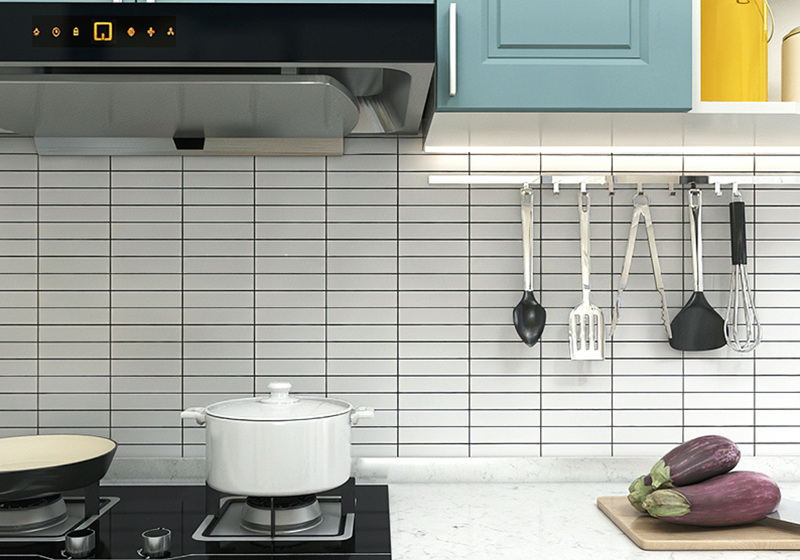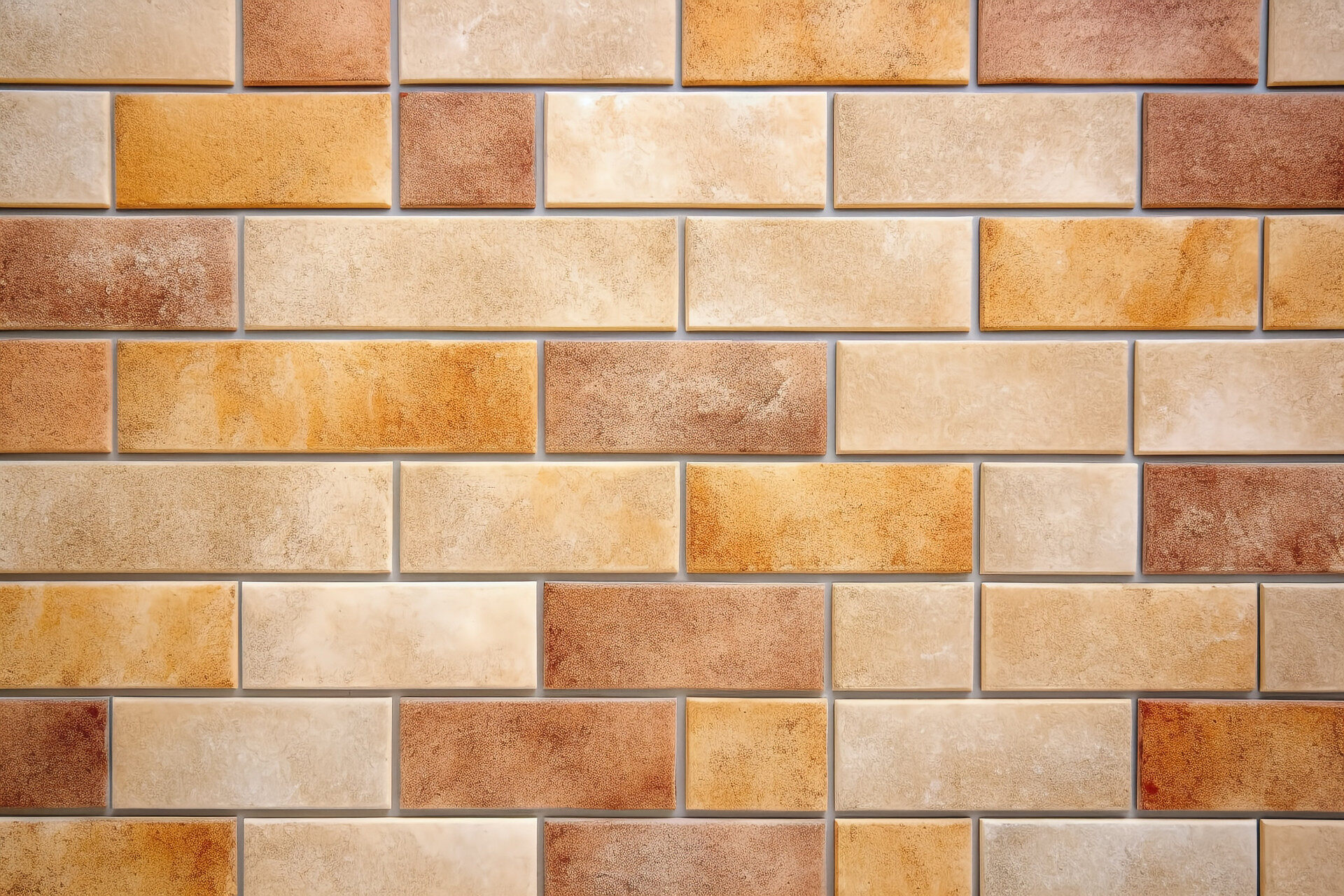Utilizing White Kitchen Wall Tiles with Grey Grout: Design Inspirations & Practical Tips
The concept of employing white tiles with grey grout in kitchen design has surged in popularity due to its captivating visual contrast and versatile application. This striking combination offers a sophisticated yet modern aesthetic, seamlessly adaptable to diverse styles. Its timeless elegance, coupled with the ability to serve as a versatile canvas for creative expression, has made it a staple choice, redefining kitchen aesthetics with its enduring appeal.
I. Why White Kitchen Wall Tiles with Grey Grout?
1. Advantages of White Kitchen Wall Tiles with Grey Grout?
Durability and Practicality: White kitchen wall tiles with grey grout offer a blend of durability and practicality. The tiles themselves are typically made of materials like ceramic or porcelain, known for their resilience against stains, moisture, and heat. Grey grout, being a neutral color, tends to hide dirt and stains better than white grout, thus making maintenance easier and the overall appearance more long-lasting.
Visual Appeal: The combination of white tiles with grey grout creates a striking visual contrast. The grey grout lines add definition to the individual tiles, giving them a crisp and clean look. This contrast can make the tiles stand out, adding depth and dimension to the kitchen walls. The simplicity of white tiles with the subtle addition of grey grout lines can also contribute to a modern and minimalist aesthetic.
Ease of Maintenance: Grey grout is less prone to discoloration compared to lighter grout colors, such as white or beige, which can easily show stains or wear over time. This aspect simplifies maintenance, requiring less frequent cleaning and providing a cleaner appearance for a longer period.
2. Complementary Styles for Different Kitchen Styles
Modern and Contemporary Kitchens: The clean lines and minimalistic appeal of white tiles with grey grout align well with the sleekness of modern kitchen designs. The contrast can emphasize the contemporary look, especially when paired with stainless steel appliances and minimalist cabinetry.
Traditional Kitchens: Surprisingly, this combination can also complement traditional kitchens. It offers a fresh, timeless appearance while preserving the classic charm of a traditional kitchen. The grey grout can add a touch of modernity without overwhelming the traditional elements.
Transitional Styles: For kitchens blending modern and traditional elements, white tiles with grey grout act as a bridge between the two. The contrast adds a contemporary touch while maintaining a sense of familiarity with more traditional elements.
Rustic or Farmhouse Kitchens: While it might seem contrary, the contrast between the white tiles and grey grout can work in rustic settings. The crispness of the tiles can enhance the cozy and inviting feel of a rustic or farmhouse-style kitchen by providing a clean backdrop against warm wood tones and natural textures.
II. Design Ideas of White Kitchen Wall Tiles with Grey Grout?
A. Creating Depth and Contrast
Using 4x12 matte subway tiles with grey grout can produce a striking visual impact. The grey grout lines between the white tiles serve to enhance the patterns by creating distinct separation and contrast. The larger size of the subway tiles allows for a more pronounced display of the grey grout, accentuating the linear layout and creating depth within the design.
Example Applications:
Herringbone Pattern: Lay the subway tiles in a herringbone pattern using grey grout. This layout not only amplifies the visual interest but also adds a sense of movement to the wall, making the space dynamic.
Vertical Stacking: Install the tiles in a vertical stack with grey grout lines to draw the eye upward, making the kitchen appear taller and more spacious.
Impact on Design: The grey grout acts as a defining element, emphasizing the shape and layout of the tiles, ultimately contributing to a more visually engaging wall surface.
B. Playful Patterns and Accents
Integrating yellow patterned tiles as accents amidst the white subway tiles offers an opportunity to infuse personality into the kitchen without overpowering the design.
Strategies for Integration:
Border or Mosaic: Use the yellow patterned wall tiles as a border or in a mosaic pattern. Limiting their use to specific areas, like a border around the backsplash or as intermittent accents, prevents overwhelming the space while adding pops of color.
Feature Wall: Create a feature wall using a section of the pattern of yellow tiles within the white subway tile backdrop. This allows for a focal point without dominating the entire kitchen.
Design Balance: By strategically placing the yellow patterned tiles, you achieve a playful and vibrant atmosphere while maintaining a harmonious balance with the predominant white and grey color scheme.
C. Tile Sizes and Layouts
Incorporating 3x6 ceramic wall tiles in conjunction with larger formats, like the 4x12 matte subway tiles, offers versatility and visual interest.
Maximizing Visual Appeal:
Mixing Tile Sizes: Combine the smaller 3x6 tiles with the larger subway tiles to create textural diversity and add intricacy to the design. For instance, use the smaller tiles as a border or in between larger tiles to break the monotony and introduce detail.
Diagonal Layout: Experiment with laying the tiles diagonally. This layout technique can make the space feel larger and more dynamic, especially when combining different tile sizes.
Visual Impact: The interplay of various tile sizes and layouts creates visual intrigue, breaking up uniformity and adding a sense of movement and dimension to the kitchen walls.
III. Practical Tips for Installation and Maintenance of White Kitchen Wall Tiles with Grey Grout
Installation Tips for White Tiles with Grey Grout
Preparation: Ensure the surface is clean, dry, and properly primed before tiling. This step is crucial for optimal adhesion.
Grout Selection: Choose a high-quality, stain-resistant grey grout suitable for your tiles. Conduct a small test area to ensure the grout doesn’t stain or discolor the tiles.
Tile Layout: Plan the tile layout beforehand to achieve symmetry and avoid awkward cuts. Use tile spacers to maintain consistent spacing between tiles for uniform grout lines.
Grouting Process: Apply the grout evenly across the tiles, working it into the joints at a 45-degree angle. Use a grout float to press the grout firmly into the spaces while ensuring no air pockets are left behind.
Cleaning Grout Residue: After the grout has set for about 20-30 minutes, wipe away excess grout with a damp sponge. Rinse the sponge frequently and avoid using too much water, as it can weaken the grout.
Finishing Touches: Once the grout is dry, buff away any haze on the tiles with a dry cloth. Seal the grout as per manufacturer recommendations to enhance its longevity and protect against staining.
Maintenance Tips for Long-lasting Aesthetics
Regular Cleaning: Routinely clean the tiles and grout using a mild detergent and water solution. Avoid abrasive cleaners that could damage the grout or tiles.
Sealing Grout: Reapply grout sealer annually or as recommended by the manufacturer to maintain its resistance against stains and moisture.
Preventing Stains: Quickly clean spills to prevent them from seeping into the grout lines. A baking soda and water paste can help lift stains from grout if needed.
Gentle Scrubbing: For tougher stains on grout, use a soft-bristled brush or an old toothbrush to gently scrub the affected areas.
Avoid Harsh Chemicals: Steer clear of harsh cleaning chemicals that could degrade the grout or tiles. Opt for pH-neutral cleaners specifically formulated for tile and grout.
Regular Inspections: Periodically inspect the grout for any cracks or signs of wear. Address any issues promptly to prevent further damage.
IV. Case Studies and Inspirational Examples about Design Ideas of White Kitchen Wall Tiles with Grey Grout
1. Modern Minimalism:
Design Elements: In a modern kitchen, large format white tiles with grey grout create a clean, sleek backdrop. Integrated appliances, minimalist cabinetry, and stainless steel accents enhance the contemporary feel. The grey grout lines accentuate the tile layout, providing a subtle yet effective visual contrast.
2. Classic Elegance:
Design Elements: In a classic kitchen, white subway tiles with grey grout evoke a timeless charm. Paired with traditional cabinetry, marble countertops, and brass fixtures, the tiles with grey grout add depth and sophistication. The contrast highlights the classic subway tile pattern while maintaining an air of elegance.
3. Rustic Warmth:
Design Elements: Even in a rustic kitchen, white tiles with grey grout find their place. They offer a clean canvas against reclaimed wood elements, farmhouse-style cabinetry, and earthy tones. The grey grout complements the rustic setting by providing a subtle contrast without overwhelming the warmth of the space.
4. Eclectic Fusion:
Design Elements: In an eclectic kitchen, white tiles with grey grout serve as a versatile base. They allow for diverse accents, from vibrant patterns to mixed materials. Bright yellow or patterned tiles strategically integrated as accents pop against the neutral backdrop, adding personality without disrupting the overall design harmony.
5. Transitional Blend:
Design Elements: In a transitional kitchen, the combination of white tiles and grey grout bridges contemporary and traditional elements. Shaker-style cabinets, quartz countertops, and sleek fixtures harmonize with the tiles' crispness. The grey grout lines subtly define the tiles, contributing to a balanced, transitional aesthetic.
6. Industrial Chic:
Design Elements: White tiles with grey grout can also find their place in an industrial-style kitchen. Against exposed brick walls, metal accents, and concrete countertops, these tiles offer a clean, industrial backdrop. The grey grout lines complement the rawness of the industrial design while adding a touch of modernity.
Conclusion
The fusion of white kitchen wall tiles with grey grout has become a prevailing choice in kitchen design due to its captivating visual appeal and adaptable nature. This versatile combination offers a sophisticated, modern aesthetic adaptable to various styles, embodying timeless elegance while providing a canvas for creative expression. From durability to enhancing visual depth, the advantages of this pairing are evident. It complements a spectrum of kitchen styles, from modern and transitional to rustic and eclectic, seamlessly integrating into each design theme.
Design inspirations range from creating depth with matte subway tiles to integrating playful accents like yellow patterned tiles, providing practical tips for installation and long-term maintenance. Real-life case studies illustrate how this combination adapts effortlessly across diverse kitchen styles, whether fostering a clean backdrop for industrial chic or exuding classic charm in traditional settings. Ultimately, the white tiles with grey grout combination redefine kitchen aesthetics, offering enduring allure and flexibility.


